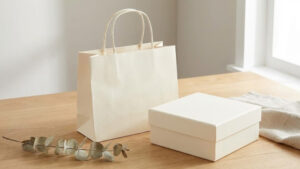Last Updated on June 6, 2024 by Packoi Team
Choosing the right paper weight is crucial for your print projects. It affects the quality, feel, and appearance of your final product. Tangible marketing materials, such as brochures, catalogs, or direct mail, still play a significant role in consumer decision-making. According to a study by MarketingSherpa, 82% of internet users trust print ads when making a purchase decision more than any other medium. This blog will cover the different types of paperweights, how they’re measured, and tips for selecting the best one. The goal is to help your business make informed decisions for your printing needs.

What Is Paper Weight?
Paper weight refers to the thickness and heaviness of paper. It determines how sturdy and durable the paper feels and affects its quality and usability. Heavier paper is thicker and feels more substantial, while lighter paper is thinner and more flexible.
For example, standard office paper is light and easy to handle. It’s great for everyday printing tasks like memos and emails. On the other hand, a business card uses heavy paper. This gives it a solid and professional feel.
The right paper weight can make a big difference in your printed materials. It impacts how your product looks and how it’s perceived.
How Paper Weight Is Determined
Understanding how paper weight is determined helps you choose the right paper for your needs. Two main methods for measuring paper weight are U.S. Basis and Metric weights.
U.S. Basis Weight:
In the U.S., paper weight is measured by the weight of 500 sheets of paper in its uncut size. This method is called U.S. Basis Weight. The weight is expressed in pounds. For example, 20 lb bond paper means that 500 sheets of this paper weigh 20 pounds before they are cut to their final size. This measurement helps printers and businesses choose the right paper for different purposes.
Metric Weight:
Metric weight is another common way to measure paper weight. It uses GSM, which stands for grams per square meter. GSM measures the paper’s density. It tells you how much a square meter of paper weighs. Higher GSM numbers mean heavier and thicker paper. For instance, 80 GSM paper is lighter and thinner than 300 GSM paper. This method is widely used worldwide and clearly explains the paper’s heft.
Common Paper Weight
Paper comes in different weights. Understanding each weight can help you choose the best packaging and marketing needs. Here’s a breakdown of common paper weights:
20-24 lb Paper
This weight means the paper is light and flexible. It’s commonly used for everyday printing tasks like memos, emails, and drafts. Businesses can use this paper for internal documents. It’s cost-effective and easy to handle. This weight is perfect for high-volume printing, making it a staple in office settings.
28-32 lb Paper
This paperweight offers a sturdier feel and is used for reports, proposals, and presentations. It is more durable than lighter paper. It’s great for double-sided printing, reducing show-through. Businesses can use it for important documents that need a professional touch. It’s ideal for making a strong impression in meetings and pitches.
40-100 lb Paper
This range covers mid-weight to heavy paper. It is commonly used for brochures, booklets, and flyers. Heavier paper in this range adds a premium feel to printed materials. Businesses can use this weight for marketing materials. It’s perfect for creating high-quality promotional items that stand out.
100-130 lb Paper
This heavy paper is often used for business cards and invitations. It provides a substantial and professional feel, is durable, and is less prone to creasing. Businesses can use this weight to create impressive business cards and elegant invitations, helping boost brand image and make a lasting impression.
140 lb and Up
This is the heaviest paper used for hardcover books and packaging. It offers maximum strength and protection. Businesses can use this paperweight for packaging high-end products. It ensures durability and premium presentation. It’s ideal for projects that require extra sturdiness and a luxurious feel.

Basics of Paper
In the printing world, “stocks” refer to different paper types. Choosing the right stock is essential for achieving your printed materials’ desired look and feel. Let’s explore the two main types: coated and uncoated stocks.
- Coated Stocks
Coated stock is paper-treated with a coating to create a smooth, shiny surface. This coating can be gloss, matte, or silk. The coated paper enhances images and colors, making them vibrant and sharp. It’s ideal for marketing materials like brochures, magazines, and flyers. The coating prevents ink from soaking into the paper, producing crisp prints. Businesses use coated paper to create polished and professional-looking materials. Its high-quality finish is perfect for showcasing graphics and photos, helping your brand stand out.
- Uncoated Stocks
Uncoated stock is paper that has not been treated with any coating, giving it a natural, absorbent surface. This paper is easy to write on and is often used for everyday business needs. Uncoated stocks are perfect for letterheads, envelopes, and notepads. The lack of coating makes the paper softer and suitable for text-heavy documents. It offers a classic and elegant look, making it ideal for books, manuals, and stationery. Businesses choose uncoated paper for its versatility and professional appearance, ensuring a quality finish for various printing needs.
Different Types of Printing Paper Weight and Uses
Understanding the different types of printing paper and their weights helps you choose the best paper for your business needs. Here’s a breakdown of common types of paper, their usual weights, and their typical uses.
Bond Paper
Bond paper is durable and high-quality and commonly used in offices. It typically weighs between 16 and 36 pounds. This paper is perfect for everyday printing tasks like memos, letters, and reports. Businesses also use bond paper for stationery, including letterheads and envelopes. Its versatility makes it a staple in office settings.
Book Paper
Book paper is specifically designed for printing books and publications. It usually weighs between 30 and 115 pounds. This type of paper is ideal for printing books, booklets, catalogs, and magazines. Both coated and uncoated options are available, allowing you to choose the finish that best suits your publication’s needs.
Cover Paper
Also known as cardstock, cover paper is thicker and more rigid, with weights ranging from 60 to 120 pounds. It is used for business cards, menus, postcards, and invitations. Cover paper adds durability and a professional look to printed materials, making it perfect for items that require a sturdy and premium feel.
Index Paper
Index paper is stiff and smooth, often used for organizational purposes. It typically weighs between 90 and 140 pounds. Common uses for index paper include index cards, dividers, tabs, and manila folders. Its durability makes it ideal for items that are frequently handled.
Text Paper
Text paper is a high-quality, versatile paper used for printing documents. It weighs 50 to 100 pounds and is suitable for flyers, brochures, newsletters, and marketing materials. Text paper comes in various finishes, such as uncoated, matte, and glossy, allowing you to select the best option for your print project.
Bristol Paper
Bristol paper is a thick, sturdy paper used for high-quality printing. It usually weighs between 90 and 120 pounds. This type of paper is often used for greeting cards, promotional materials, and direct mail. Its robust nature ensures that printed items are durable and visually appealing.
Tag Paper
Tag paper is a heavy and durable stock, typically weighing between 100 and 200 pounds. It is used for hang tags, labels, and signage. Tag paper is designed to withstand frequent handling and exposure, making it suitable for items that need to be both durable and attractive.
Specialty Paper
Specialty paper includes various unique papers for specific applications, varying weight widely. It is used for custom projects like wedding invitations, certificates, and art prints. Specialty papers often have unique textures and finishes, adding a distinct touch to your printed materials.
Different Paper Types Comparision Table
| Paper Type | Usual Weight (lb) | Common Uses |
| Bond Paper | 16-36 | Memos, letters, reports, stationery |
| Book Paper | 30-115 | Books, booklets, catalogs, magazines |
| Cover Paper | 60-120 | Business cards, menus, postcards, invitations |
| Index Paper | 90-140 | Index cards, dividers, tabs, manila folders |
| Text Paper | 50-100 | Flyers, brochures, newsletters, marketing materials |
| Bristol Paper | 90-120 | Greeting cards, promotional materials, direct mail |
| Tag Paper | 100-200 | Hang tags, labels, signage |
| Specialty Paper | Varies widely | Wedding invitations, certificates, art prints |
Why Is Paper Weight Important for Printed Marketing Materials?
Choosing the right paper weight is crucial for printed marketing materials. Here are three important reasons why paperweight matters:
1. Enhances Perceived Quality
The weight of the paper directly affects the perceived quality of your marketing materials. The heavier paper feels more substantial and premium, giving a sense of durability and professionalism. Moreover, According to a study, high-quality paper can significantly enhance the perceived value of a product. This is especially important for business cards, brochures, and flyers, where first impressions matter. Using the right paper weight can make your materials stand out and leave a lasting impression on potential clients.
2. Improves Print Quality
Paper weight also impacts the print quality of your materials. Heavier paper can better handle ink saturation, preventing issues like bleeding and show-through. This results in sharper images and clearer text, enhancing the overall appearance of your marketing pieces. High-quality prints are essential for maintaining your brand’s image and communicating your message effectively.
3. Increases Durability
Marketing materials are often handled frequently, so durability is key. Heavier paperweights provide greater resistance to wear and tear, ensuring your materials look fresh and professional over time. This is vital for materials like menus, business cards, and direct mailers that must withstand repeated use and handling. Durable materials reflect positively on your brand, showing that you prioritize quality and attention to detail.

How to Choose the Right Paper Weight
Now that you know about paperweights in denial, you might wonder which paperweight is right for your business. Well, here are some detailed factors to consider when choosing paperweight.
Purpose and Use
The purpose of your print project greatly influences the choice of paper weight. For everyday printing tasks such as memos, drafts, and internal documents, lighter paper (20-24 lb) is ideal. Heavier paper (80-100 lb) provides a more professional and durable feel for more substantial projects like business cards, brochures, or marketing materials. Understanding the purpose helps ensure the right balance between functionality and appearance.
Design
The design of your printed materials plays a crucial role in determining the appropriate paper weight. If your design includes heavy ink coverage, detailed graphics, or high-quality photos, opting for thicker paper helps prevent show-through and enhances the print quality. The heavier paper supports vibrant colors and sharp images, making your designs stand out and look more professional.
Budget
Your budget is a significant factor when choosing paperweight. Heavier paper tends to be more expensive, so balancing quality with cost is important. For high-end marketing materials, investing in premium paper can pay off by creating a more impressive impact. More affordable, lighter paper might be sufficient for internal documents or large print runs. Always aim to choose the best paper weight that your budget allows.
Printer Capabilities
Check the specifications of your printer before selecting a paperweight. Not all printers can handle heavy paper, and using the wrong weight can cause jams and poor print quality. Ensure that your printer is capable of managing the weight you choose. For instance, most office printers can handle up to 80 lb, but you might need a specialized printer for heavier weights.
Durability
Another important consideration is the durability of your printed materials. If the materials will be frequently handled, like menus, manuals, or business cards, choosing a heavier and more durable paper ensures they last longer and maintain their appearance. Paper thickness resists wear and tear better than lighter paper.
Mailing Needs
When mailing printed materials, consider the paperweight to manage postage costs. Heavier paper increases shipping expenses. If you need to mail large quantities, using lighter paper can save money on postage. However, ensure the paper is still sturdy enough to arrive in good condition. For direct mail campaigns, balance weight and durability to optimize cost and impact.
Environmental Impact
Consider the environmental impact of your paper choice. Recycled paper options are available in various weights and can be a good choice for eco-conscious businesses. While recycled paper might cost more, it demonstrates your commitment to sustainability, which can be a positive message for your audience.
Packoi Helps You Choose the Right Paper Weight for Your Brand
Selecting the right paper weight for your business is a decision that significantly affects your marketing and packaging materials—balance functionality and aesthetics to create materials that represent your brand effectively.
If you need expert advice about your options, Packoi is here to help. We offer various customized packaging and marketing materials, ensuring you find the perfect solution. Our team of qualified designers is ready to assist you in creating high-quality, impactful print materials.




